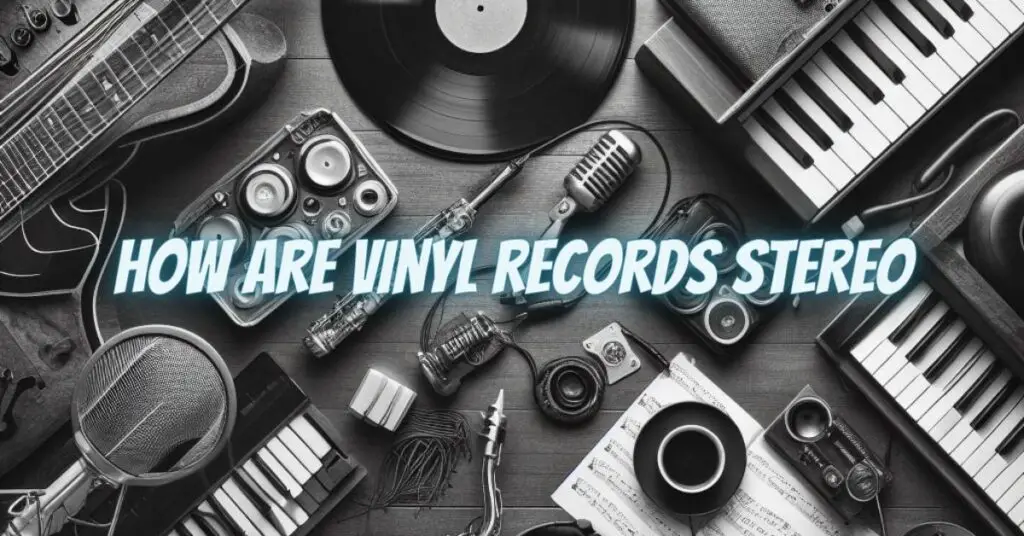Vinyl records have long been celebrated for their rich, warm sound, and their ability to deliver both mono and stereo recordings. While mono records provide a single audio channel, stereo records create a more immersive listening experience by using two separate audio channels. Here’s an exploration of how vinyl records achieve stereo sound.
Understanding Stereo Sound
- Stereo Basics:
- Two Channels: Stereo sound uses two distinct audio channels, left and right, to create a sense of spatial sound. This allows for the placement of different sounds at various positions within the stereo field, providing a more natural and immersive listening experience.
- Soundstage: Stereo recordings can create a soundstage, where instruments and vocals can be positioned across a horizontal plane, simulating the experience of live music and enhancing the perception of depth and space.
Stereo Vinyl Recording Process
- Stereo Recording:
- Microphone Placement: During the recording process, multiple microphones are used to capture sound from different angles and distances. These microphones feed into separate audio channels (left and right), capturing the spatial characteristics of the performance.
- Mixing: In the mixing stage, audio engineers adjust the levels, panning, and effects for each channel, creating a balanced stereo mix. Elements like vocals, instruments, and effects can be positioned within the stereo field to achieve the desired spatial effect.
- Mastering for Vinyl:
- Mastering Engineer: The stereo mix is sent to a mastering engineer, who prepares the final version of the audio for vinyl pressing. The mastering process involves equalization, compression, and other adjustments to ensure the best possible sound quality on vinyl.
- Creating the Master Disc: The mastered stereo audio is transferred to a lacquer master disc using a lathe. The lathe cuts the grooves into the lacquer, encoding the stereo information. The groove depth and width vary with the amplitude and frequency of the audio signal.
How Stereo is Encoded on Vinyl
- Groove Modulation:
- 45-Degree Angles: On a stereo vinyl record, the groove walls are modulated at a 45-degree angle to the surface of the disc. This allows each wall of the groove to carry one of the two stereo channels—left and right.
- Lateral and Vertical Movements: The lateral (side-to-side) movement of the groove corresponds to the sum of the left and right channels (mono information), while the vertical (up-and-down) movement corresponds to the difference between the left and right channels (stereo information).
- Reading Stereo Grooves:
- Stylus Movement: When a turntable’s stylus (needle) traces the groove, it moves in response to the lateral and vertical modulations. The stylus vibrates in two directions, capturing the stereo information encoded in the groove.
- Cartridge Conversion: The stylus’s vibrations are converted into electrical signals by the cartridge. The cartridge has separate coils for the left and right channels, which generate corresponding electrical signals that are then amplified and sent to the speakers.
Advantages of Stereo Vinyl
- Enhanced Listening Experience:
- Spatial Sound: Stereo vinyl records provide a richer and more immersive listening experience compared to mono records. The spatial separation of sounds creates a more lifelike and engaging audio environment.
- Depth and Clarity: Stereo recordings can offer greater depth and clarity, making it easier to distinguish individual instruments and vocals. This adds to the overall enjoyment and appreciation of the music.
- Artistic Expression:
- Creative Control: Artists and producers can use the stereo field creatively, placing sounds in different positions to enhance the musical narrative and emotional impact. This allows for more dynamic and interesting recordings.
Conclusion
Stereo vinyl records achieve their immersive sound by encoding two separate audio channels into the groove walls at a 45-degree angle. The recording and mastering processes involve capturing and mixing audio in a way that takes advantage of the stereo field, creating a rich and spatial listening experience. The modulation of the groove walls and the stylus’s ability to read these modulations enable vinyl records to deliver the depth, clarity, and dimensionality that stereo sound offers. This technological marvel, combined with the tactile and nostalgic appeal of vinyl, continues to make stereo vinyl records a cherished format for music enthusiasts.

